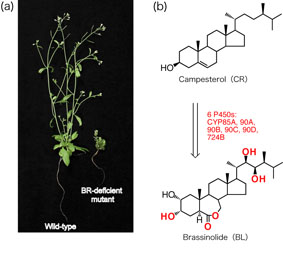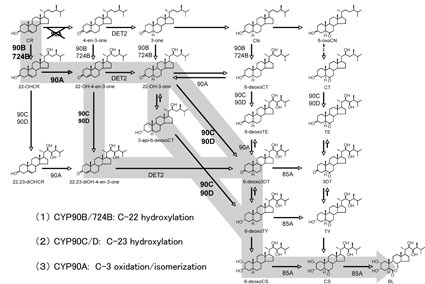Assistant Professor Mizutani, M., and Research Group, “Biochemical Characterization of P450s Reveals a New Pathway of Brassinosteroid Biosynthesis” (Published in 30 Nov 06 / Topics in July 07)
|
Assistant Professor Mizutani, M., and research group,
Published in Plant Cell, 30 November 2006. |
|
|
Cytochrome P450 (P450) is a heme-containing membrane protein and catalyzes the monooxygenation reaction (RH + O2 + NADPH2+ → ROH + H2O + NADP+). P450s are involved in biosynthesis of a variety of plant hormones and plant bioactive substances. Brassinosteroids (BRs) are a group of plant steroid hormones that regulate plant development, xylogenesis, and photomorphogenesis. |
 Assist Prof MIZUTANI, M(left); Dr OHNISHI, T(center); Prof Em SAKATA, K(right) |
| The structural variability of BRs derives from the presence of several oxygen moieties at positions C-2, C-3, and C-6 in the A/B-rings and at positions C-22 and C-23 in the side chain. Genetic analyses of several BR biosynthesis mutants have revealed that these oxidative substitutions are introduced into steroids by 6 different P450 genes (CYP85A, 90A, 90B, 90C, 90D, and 724B) (Fig. 1). However, among BR-biosynthetic P450s, only the CYP85A family has been characterized by functional expression in yeast cells, and the catalytic activities of the other P450s had been unknown until our biochemical studies. | |
 |
Fig. 1 (a) Phenotype of brassinosteroid-deficient mutant. (b) Cytochrome P450 monooxygenases involved in brassinosteroid biosynthesis. |
|
Mizutani et al. have succeeded in the biochemical characterization of these P450s. The P450s were expressed in a baculovirus-insect cell system, and all the intermediates in BR biosynthesis were prepared by organic synthesis. Their catalytic activities were determined in the enzyme assays with the recombinant proteins and the synthetic substrates, and the reaction products were quantitatively analyzed by GC-MS and LC-MS. These biochemical studies have identified new activities for the P450s (Fig. 2). In addition, BRs were previously thought to be biosynthesized from the pathway via campestanol, and however, these studies have demonstrated that BRs are biosynthesized via the new campestanol-independent pathway (Fig. 2). BRs are important plant hormones for agriculture, and therefore, they are expected to improve crop production and to modify morphology of flowers and ornamental plants either by chemical inhibitors or by genetic manipulation for BR-related enzymes. |
|
 Fig. 2 The new campestanol-independent pathway of brassinosteroid biosynthesis. |
|
| These works were published in Bioscience, Biotechnology, and Biochemistry, 7th September 2006 (Biosci. Biotechnol. Biochem. 70, 2071-2080 (2006)), and in the Plant Cell, 30th November 2006 (Plant Cell, 18, 3275-3288 (2006)). In addition, the B.B.B. paper has been awarded a prize of “Award for Excellence to Authors Publishing in Bioscience, Biotechnology, and Biochemistry in 2006” on 24th March 2007. | |
 Institute for Chemical Research, Kyoto University
Institute for Chemical Research, Kyoto University International Joint Usage Research Center
International Joint Usage Research Center